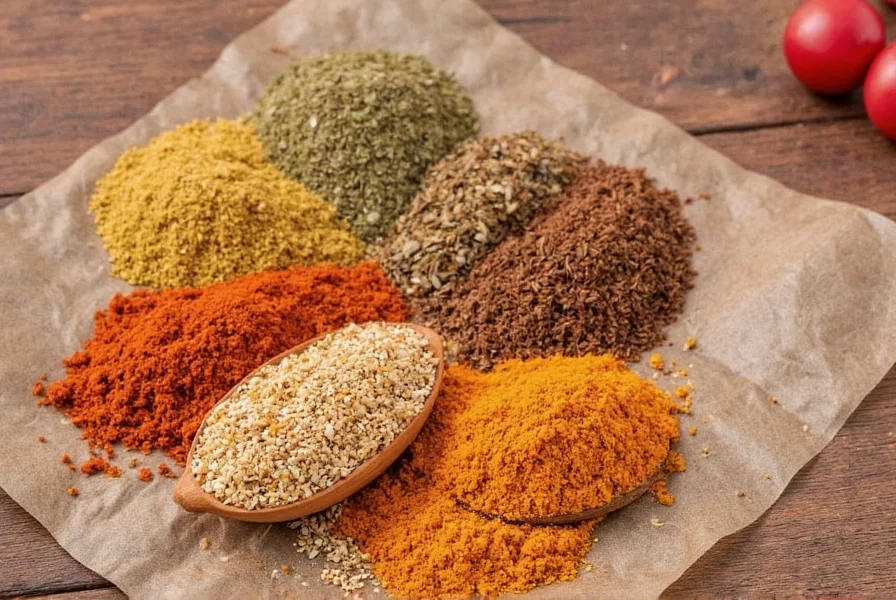When you're in the middle of cooking and realize you've run out of cumin, knowing effective replacements can save your recipe. Cumin's distinctive earthy, warm, and slightly citrusy flavor is essential in many global cuisines, but several alternatives can fill in when needed. Understanding what makes cumin unique helps you choose the right substitute for your specific dish.
Understanding Cumin's Flavor Profile
Cumin brings a warm, earthy flavor with subtle citrus notes and a slight bitterness that adds depth to dishes. Its distinctive aroma comes from compounds like cuminaldehyde. This spice works as both a flavor enhancer and aromatic foundation in many recipes. When seeking a cumin replacement, consider whether you need to replicate its earthiness, warmth, or distinctive aroma - or all three aspects.
Top Cumin Substitutes Explained
Chili Powder: Best for Mexican Dishes
Chili powder often contains cumin as a primary ingredient along with garlic powder, oregano, and paprika. This makes it an excellent cumin replacement specifically for Mexican recipes like tacos, enchiladas, and chili. Use a 1:1 ratio when substituting, but be aware that chili powder brings additional flavors beyond just cumin. For the best substitute for cumin in chili, chili powder works perfectly since most blends already contain cumin.

Coriander: Ideal for Indian Cooking
Coriander seeds share cumin's earthy quality but with brighter citrus notes and less intensity. This makes coriander an excellent choice when looking for a cumin replacement for Indian cooking. Use 1.5 times the amount of coriander to replace cumin, as it's milder. Coriander works particularly well in curry blends, dals, and rice dishes where cumin would normally feature.
Garam Masala: Complex Flavor Alternative
Garam masala typically contains cumin along with other warming spices like cardamom, cloves, and cinnamon. This blend provides a more complex flavor profile that can substitute for cumin in many applications. Use half the amount of garam masala compared to cumin required. This works well as a cumin alternative for people with allergies to single spices since it distributes the flavor across multiple components.
Smoked Paprika: For Depth Without Earthiness
Smoked paprika offers the earthy depth of cumin without the distinctive cumin flavor. It brings a different kind of warmth and smokiness that works well in certain applications. Use a 1:1 ratio when substituting. This is particularly effective as a cumin replacement for vegetarians who want depth in bean dishes without the specific cumin flavor.
Caraway Seeds: Closest Flavor Match
Caraway shares chemical compounds with cumin, making it the closest flavor relative. The flavors are similar but caraway has a more pronounced anise note. Use a 1:1 ratio when substituting. This works best in European and Middle Eastern dishes where cumin might otherwise be used. For those wondering what spice can I use instead of cumin with the most similar profile, caraway is your answer.
| Substitute | Flavor Profile | Best Used In | Substitution Ratio |
|---|---|---|---|
| Chili Powder | Earthy, spicy, complex | Mexican dishes, chili, tacos | 1:1 |
| Coriander | Citrusy, floral, mild earthiness | Indian curries, rice dishes | 1.5:1 |
| Garam Masala | Warm, complex, aromatic | Curries, stews, braises | 0.5:1 |
| Smoked Paprika | Smoky, deep, slightly sweet | Bean dishes, rubs, sauces | 1:1 |
| Caraway Seeds | Earthy, with anise notes | European dishes, breads, sauerkraut | 1:1 |
When Substitution Matters Most
Not all recipes tolerate cumin substitutions equally. In dishes where cumin is the star flavor (like certain Indian breads or Mexican mole), substitutes will noticeably change the character. However, in complex spice blends or long-simmered dishes, substitutions often work well. For those needing a cumin substitute without cumin flavor due to allergies or preferences, consider using a combination of coriander and smoked paprika to approximate the earthiness without the distinctive cumin taste.

Practical Tips for Substituting
When replacing cumin in your recipes, keep these practical considerations in mind:
- Start with less - You can always add more, but you can't remove excess spice
- Toast whole spices before grinding for maximum flavor when using alternatives like coriander or caraway
- Consider the dish's origin - Match your substitute to the cuisine (chili powder for Mexican, coriander for Indian)
- Adjust other spices - If using a blend like garam masala, reduce other warming spices slightly
- Taste as you go - Especially important when using substitutes with different intensity levels
When Not to Substitute Cumin
Some recipes rely so heavily on cumin's distinctive flavor that substitutes won't work well. These include:
- Authentic Yemeni hawaij spice blend
- Certain Mexican adobo sauces
- Traditional Indian panch phoron (when cumin is specified)
- Specific regional dishes where cumin defines the flavor profile
In these cases, it's better to make a special trip for cumin rather than compromise the dish's authenticity.
Creating Your Own Cumin Substitute Blend
For the most versatile homemade cumin replacement, try this simple blend:
- 1 tablespoon coriander seeds
- 1 teaspoon smoked paprika
- ½ teaspoon caraway seeds
- ¼ teaspoon turmeric (for color)
Toast the whole seeds in a dry pan until fragrant, then grind together. This blend works particularly well as a cumin replacement for Mexican recipes while providing complexity that mimics cumin's role in many dishes.











 浙公网安备
33010002000092号
浙公网安备
33010002000092号 浙B2-20120091-4
浙B2-20120091-4